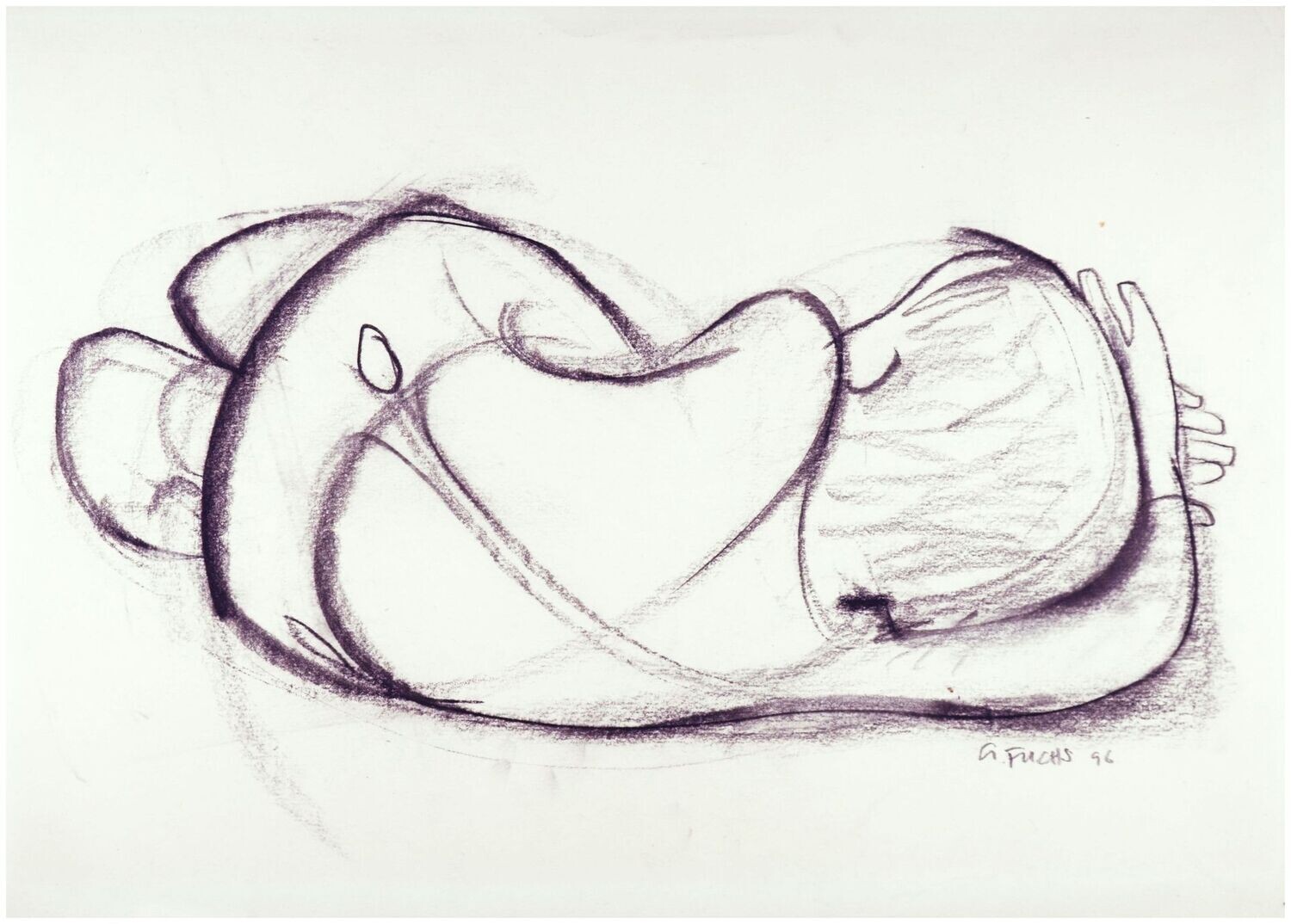Fuchs, Alfred (1925-2003), Lying Boy, 1996
Alfred Fuchs(1925 Saarbrücken - 2003 Prague), Lying Boy . Charcoal drawing on strong paper, 30 x 41.5 cm, signed A.[lfred] Fuchs and dated [19]96.
- small pinholes at corners, a little bit creased at margins, otherwise good condition
Exposé as
PDF
- Fragile childlikeness -
With this drawing, Alfred Fuchs continues his depictions of children, revisiting and reworking a motif from his 1983 print cycle Children's Lives.
The drawing depicts a young boy. Although he is dressed, wearing trousers with crossed braces and presumably shoes, the boy is crouched in a fetal position with his back to us. He wants to withdraw from everything and be all by himself. It remains unclear whether he has fallen asleep or remained awake in this position. The hands, which seem to be raised, suggest a defensive posture, as if the boy wants to stop what is destroying his childhood. The posture is one of defense and protection, which makes it all the more vulnerable and brings out the childlike in a particularly vivid way.
The boy has withdrawn from us. His individuality remains hidden by his protective turning away. In this way, the boy becomes a child as such, standing in for the childishness that Alfred Fuchs himself was robbed of all too early.
Alfred Fuchs creates the intimate and at the same time allegorical image of the child with virtuoso charcoal strokes. The entire body seems to have emerged from one continuous, curving line. It is as if the artist, in the act of drawing, has embraced the child itself, which is represented by his drawing. Despite the broad strokes, the drawing expresses a tenderness that illustrates the child's sensitivity.
About the artist
As Alfred Fuchs' father was Jewish, the family emigrated from Saarbrücken to Prague in October 1935 to escape the increasing persecution by the Nazi regime. From 1939 to 1943, Alfred Fuchs trained there as a typeface painter. In Prague, however, the family was not immune to the Nazi regime. At the height of the persecution, Alfred Fuchs was interned in the Bystrice concentration camp near Benesov in 1944. After World War II, he completed a five-year course of study with Professor Vlastimil Rada at the Academy of Fine Arts in Prague.
In his art, he initially dealt with war and persecution. In 1962-1973, together with Vendelín Zrubecký, he created a mural in Auschwitz.
Later, the depiction of children and mothers became a central moment in Alfred Fuchs' oeuvre, which also has a biographical dimension.
"A search for traces of memories of a happy, carefree childhood. A childhood that once began in Saarbrücken and was abruptly ended by the Second World War and the persecution of the Jews.
- Beate Reifenscheid
Alfred Fuchs participated in numerous international exhibitions. His works have been shown in the Czech Republic, Poland, Russia, Hungary, Germany, Norway, Monaco, Australia, New Zealand, Canada and Japan. He also received several awards and became an honorary member of the European Academy Otzenhausen in 1998.
He was not only a painter, but also an extremely virtuoso graphic artist. The Czech postage stamps produced according to his designs mark the peak of his popularity.
Selected Bibliography
Saur. Allgemeines Künstlerlexikon, Band 46, München - Leipzig 2005, S. 33.
Arno Krause u. Roswitha Jungfleisch (Hrsg.): Unter der Kerze ist Schatten. Das Leben des Malers Alfred Fuchs, Blieskastel 2005.

